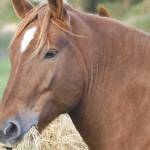Predicting Insulin Dysregulation in Horses: Biomarker Measurement

In human medicine, “metaflammation” describes the link between metabolism, obesity, and body-wide inflammation. Identification of certain biomarkers, which are measurable substances that point to disease, indicate metabolic and inflammatory glitches in humans. Given the likenesses between human and equine metabolic syndrome, could these same biomarkers forecast insulin dysregulation in horses? Researchers recently set out to determine this, with the hope of predicting insulin dysregulation in susceptible horses.*
In addition to body condition and cresty neck scores, researchers measured metabolic and inflammatory markers in 32 horses and ponies, all of which had been diagnosed with insulin dysregulation or insulin sensitivity based on the combined glucose insulin test. Twelve of the 32 horses (38%) were deemed to have insulin dysregulation, and 20 (62%) were classified as insulin sensitive.
Baseline serum or plasma concentrations of biomarkers were tested via commercial assays. After analysis, the tested biomarkers proved to be unreliable predictors of insulin dysregulation in horses. Researchers observed no difference in biomarkers between those horses diagnosed with insulin dysregulation or insulin sensitivity.
Cresty neck score, however, proved to be a stronger predictor of insulin dysregulation than generalized obesity, confirming the results of previous research.+
Although the biomarkers tested in this study cannot be used to predict potential insulin dysfunction, the results underscored the value of implementing management strategies to keep horses from becoming and staying overweight, including:
- Possessing a clear vision of moderate body condition;
- Avoiding overfeeding of calorie-dense concentrates but providing a ration balancer or vitamin and mineral supplement to satisfy requirements for vital nutrients;
- Limiting consumption of pasture when necessary, especially during times of fast growth; and
- Implementing an appropriate exercise program to prevent obesity.
Some owners find it difficult to look at their horses and ponies objectively; if this is the case, a professional nutritionist can help guide you in establishing both a baseline body condition score and a suitable ration for your horse or pony.
Check out this video in which Kentucky Equine Research nutritionists Kathleen Crandell, Ph.D., and Katie Young, Ph.D., go over ways to accurately assess body condition in horses of various ages and types, as well as tips on moving horses up and down the scale.
*Ragno, V.M., C.D. Klein, N.S. Sereda, F.D. Uehlinger, G.A. Zello, K.A. Robinson, and J.B. Montgomery. 2021. Morphometric, metabolic, and inflammatory markers cross a cohort of client-owned horses and ponies on the insulin dysregulation spectrum. Journal of Equine Veterinary Science 105:103715.
+Fitzgerald, D.M., S.T. Anderson, M.N. Sillence, and M.A. deLaat. 2019. The cresty neck score is an independent predictor of insulin dysregulation. PLos ONE:14:e0220203.








